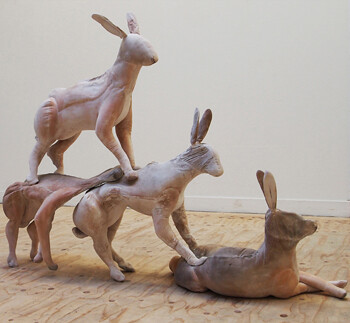April 8–13, 2014
Opening events:
Tuesday, April 8, 6–8pm
Wednesday, April 9, 6–10pm
Salone Internazionale
Via Privata Oslavia 1
20134 Milan, Italy
Hours: Tuesday–Saturday 10am–8pm,
Sunday 10am–6pm
This point in time is characterised by a tilting perspective. Growth is no longer something obvious: shrinkage is a daily reality. With the performance BACK STAGE ON STAGE, students and alumni of The Royal Academy of Art (KABK) in The Hague investigate how this new dynamic can create space for different ideas and be a breeding ground for innovation. Shrinkage as a model for growth: a manifesto!
The trans-disciplinary performance BACK STAGE ON STAGE is the Royal Academy’s seventh presentation at the Salone Internazionale del Mobile in Milan. The manifestation takes place in Ventura Lambrate from Tuesday, April 8 until Sunday, April 13.
With BACK STAGE ON STAGE, The Royal Academy of Art literally puts the creative process in the limelight. The presentation consists of a continuous programme of performances and happenings, whereby drafts and products will be created, shared, shown and dismantled on stage. In this series of special projects the limits of manipulability are tested, gravity defied and the concept of designing redefined. The programme is trans-disciplinary and shows the power of lateral thinking that is central to the academy. The presentation gives room to all artistic disciplines in design and fine art.
The interactive and participatory performances and happenings explicitly challenge the viewer to become part of the production and research process. Thus the role and position of the contemporary artist and designer are questioned. For Cutting Edge, Martijn Rigters uses a cutting technique with hot wires to shape large foam blocks into objects. Each intuitive movement of the visitor is directly translated into a form. In this way the designer manages to use the human body and each movement of the user as design tool and as essential part of the making process. The project Four Hares by Catinka Kersten also uses the direct input of visitors to create forms: her animal sculptures consist of skins of textile filled with liquid plaster. By asking a person to hold the animals while the plaster is hardening, he or she is actively involved in the realization of the end product.
In Anouk van Klaveren’s project 000 004 Hypertrichosis 2.0, the required ingredients are taken from the visitors. Anouk van Klaveren uses human hair to create bow ties on stage. Thus a growing collection will arise during the Salone del Mobile. The production process resembles a factory assembly line. The work questions the current trend among fashion houses and shops for transparency about the production process and the origin of the base materials. Consumers increasingly want to know how things are produced and where they come from. But where does one draw the line?
Drawing a line is also the focus in the The Incredible Shrinking Man Research Lab. People keep on growing taller, as a subsequence of which they need more energy, more food and more space. But what happens if one decides to break with this trend? The Incredible Shrinking Man, led by Arne Hendriks, is speculative research into the possible consequences of shrinking human beings to a height of 50 centimetres. In Milan the students’ research is shown on stage as well as in settings and assemblages of objects, ranging from drawings to sculptures.
BACK STAGE ON STAGE shows an optimistic and uninhibited attitude that does not so much focus on the end results as on the road leading there. Undeterred by any dogma, the making process takes centre stage—conventions are stretched, materials and techniques are experimented with and a new language of forms is created.
This trans-disciplinary presentation represents the departments of the KABK: ArtScience (MA & BA), Fine Arts, Graphic Design, Industrial Design (postgraduate), INSIDE Interior Architecture (MA), Interior Architecture and Furniture Design, Photography and Textile & Fashion.
BACK STAGE ON STAGE has been developed under the supervision of curator Claudia Linders and co-curators Marie Ilse Bourlanges and Elena Khurtova. The exhibition has been designed and realised by students of the Interior Architecture and Furniture Design department under the direction of Barend Koolhaas.


